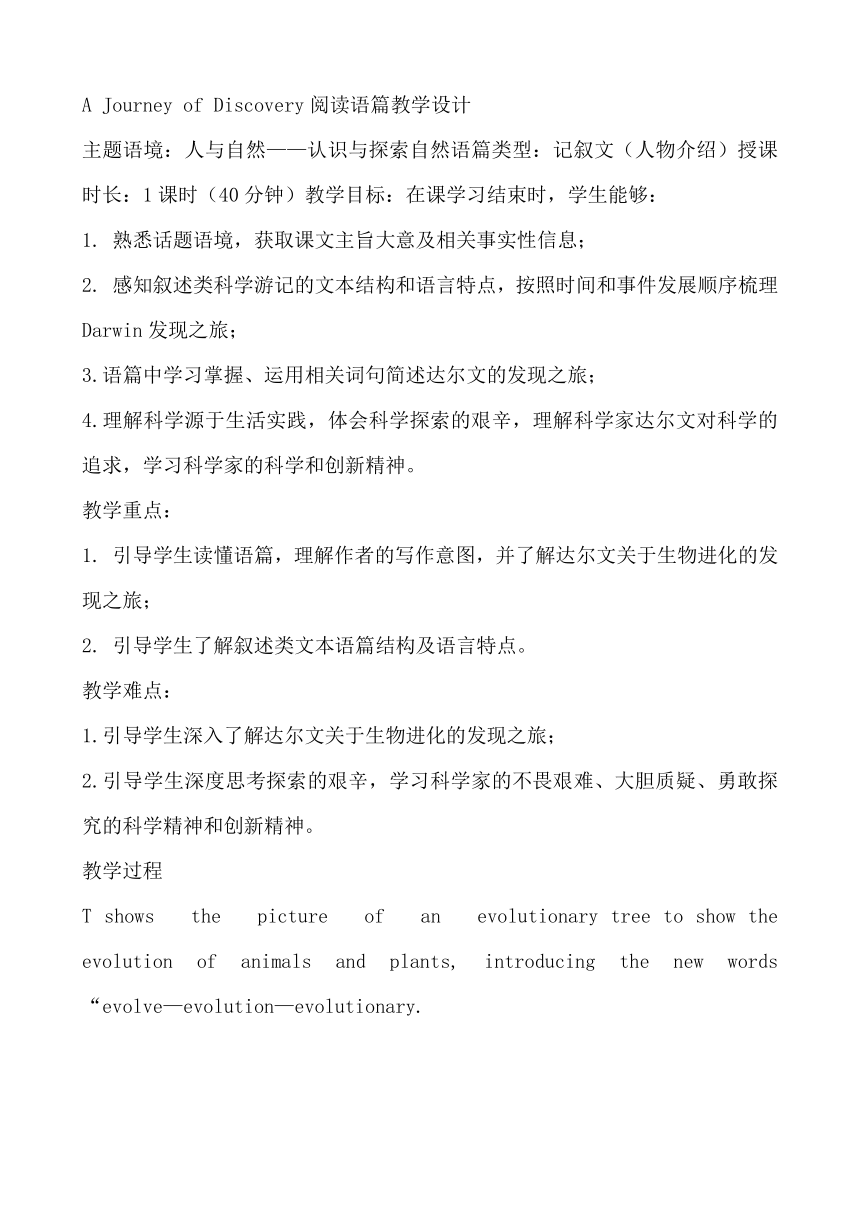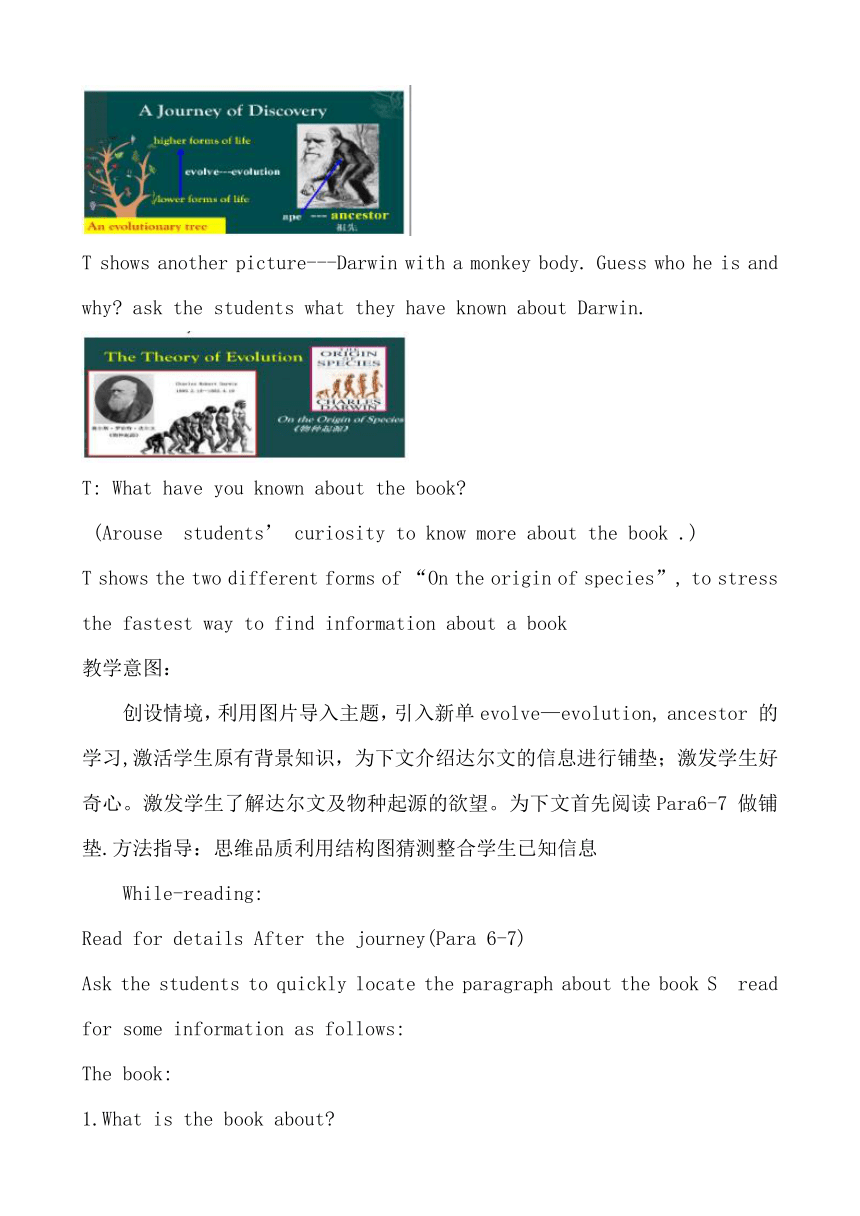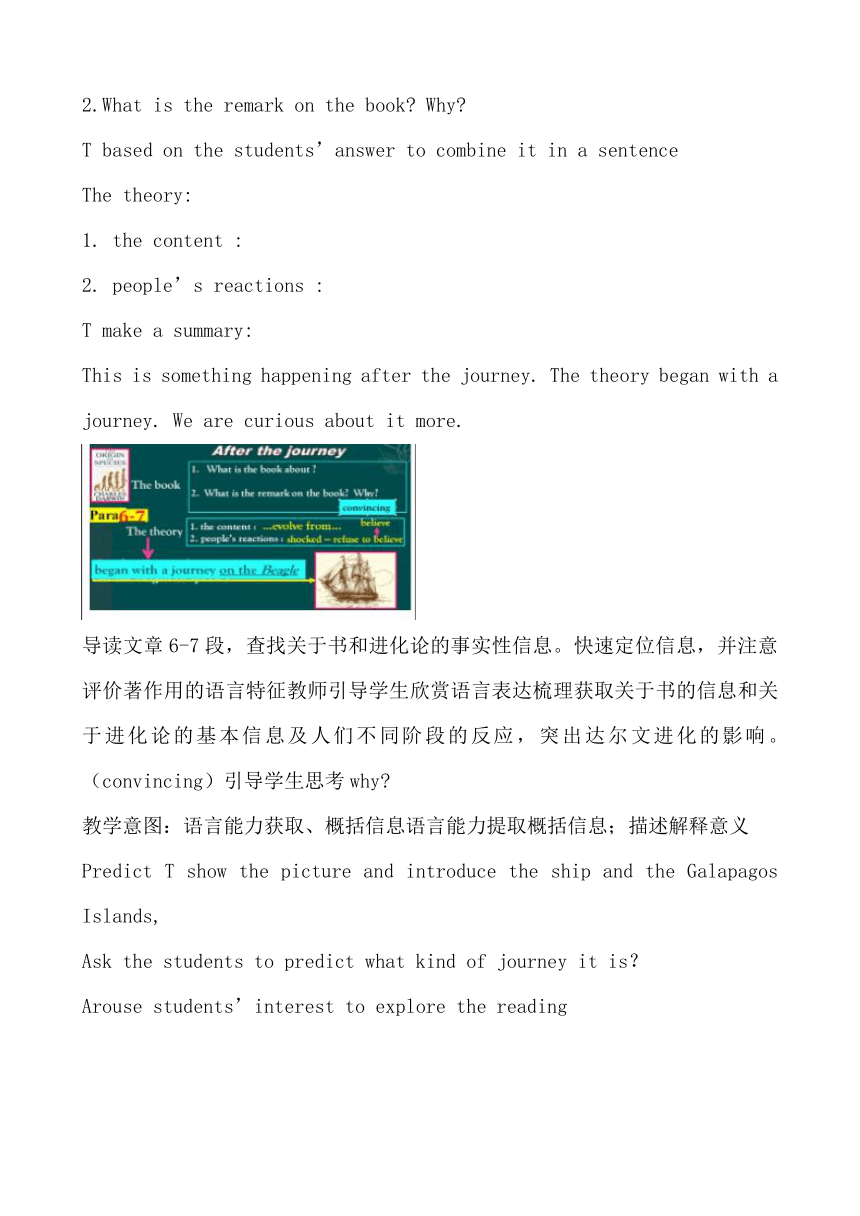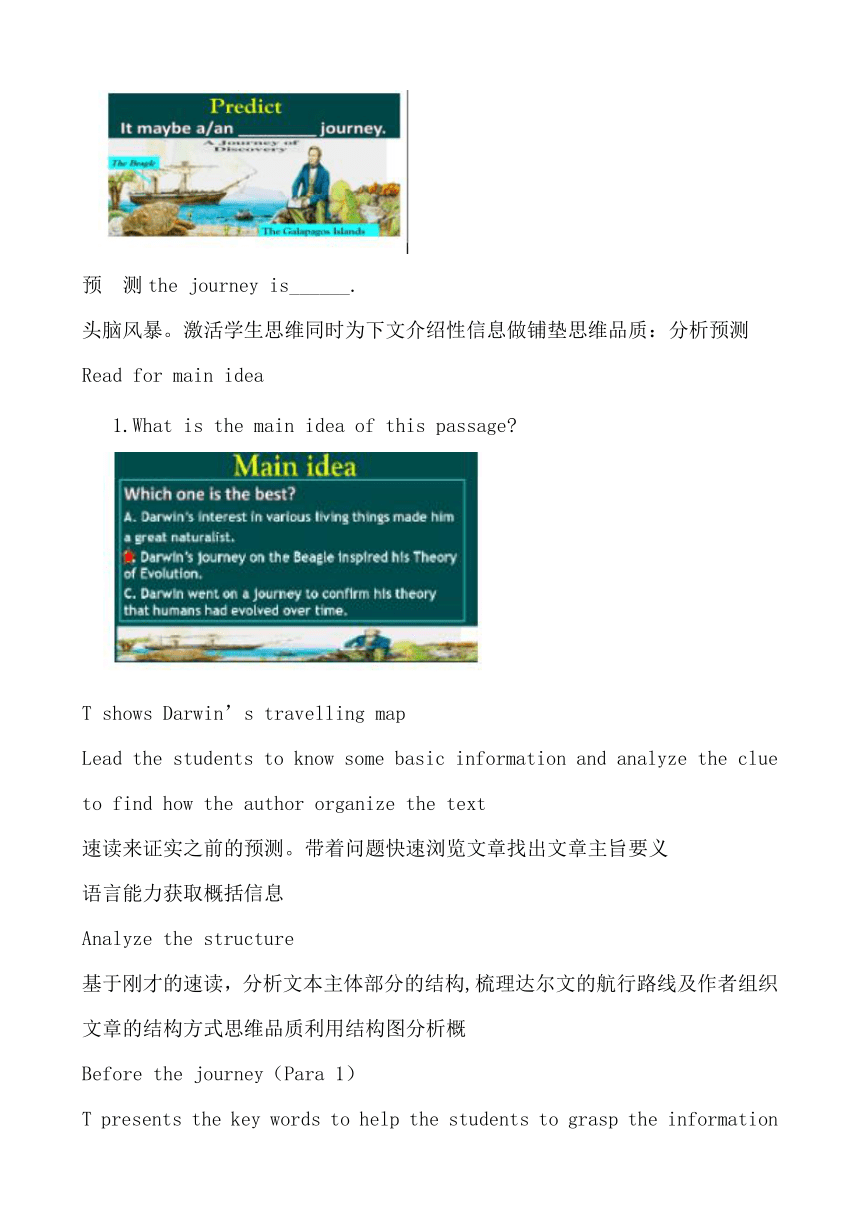外研版(2019)选择性必修一Unit 5 Revealing natureA Journey of Discovery reading 教学设计
文档属性
| 名称 | 外研版(2019)选择性必修一Unit 5 Revealing natureA Journey of Discovery reading 教学设计 |

|
|
| 格式 | zip | ||
| 文件大小 | 935.4KB | ||
| 资源类型 | 教案 | ||
| 版本资源 | 外研版(2019) | ||
| 科目 | 英语 | ||
| 更新时间 | 2022-08-28 13:40:33 | ||
图片预览




文档简介
A Journey of Discovery阅读语篇教学设计
主题语境:人与自然——认识与探索自然语篇类型:记叙文(人物介绍)授课时长:1课时(40分钟)教学目标:在课学习结束时,学生能够:
1. 熟悉话题语境,获取课文主旨大意及相关事实性信息;
2. 感知叙述类科学游记的文本结构和语言特点,按照时间和事件发展顺序梳理Darwin发现之旅;
3.语篇中学习掌握、运用相关词句简述达尔文的发现之旅;
4.理解科学源于生活实践,体会科学探索的艰辛,理解科学家达尔文对科学的追求,学习科学家的科学和创新精神。
教学重点:
1. 引导学生读懂语篇,理解作者的写作意图,并了解达尔文关于生物进化的发现之旅;
2. 引导学生了解叙述类文本语篇结构及语言特点。
教学难点:
1.引导学生深入了解达尔文关于生物进化的发现之旅;
2.引导学生深度思考探索的艰辛,学习科学家的不畏艰难、大胆质疑、勇敢探究的科学精神和创新精神。
教学过程
T shows the picture of an evolutionary tree to show the evolution of animals and plants, introducing the new words “evolve—evolution—evolutionary.
T shows another picture---Darwin with a monkey body. Guess who he is and why ask the students what they have known about Darwin.
T: What have you known about the book
(Arouse students’ curiosity to know more about the book .)
T shows the two different forms of “On the origin of species”, to stress the fastest way to find information about a book
教学意图:
创设情境,利用图片导入主题,引入新单evolve—evolution, ancestor 的学习,激活学生原有背景知识,为下文介绍达尔文的信息进行铺垫;激发学生好奇心。激发学生了解达尔文及物种起源的欲望。为下文首先阅读Para6-7 做铺垫.方法指导:思维品质利用结构图猜测整合学生已知信息
While-reading:
Read for details After the journey(Para 6-7)
Ask the students to quickly locate the paragraph about the book S read for some information as follows:
The book:
1.What is the book about
2.What is the remark on the book Why
T based on the students’answer to combine it in a sentence
The theory:
1. the content :
2. people’s reactions :
T make a summary:
This is something happening after the journey. The theory began with a journey. We are curious about it more.
导读文章6-7段,查找关于书和进化论的事实性信息。快速定位信息,并注意评价著作用的语言特征教师引导学生欣赏语言表达梳理获取关于书的信息和关于进化论的基本信息及人们不同阶段的反应,突出达尔文进化的影响。(convincing)引导学生思考why
教学意图:语言能力获取、概括信息语言能力提取概括信息;描述解释意义
Predict T show the picture and introduce the ship and the Galapagos Islands,
Ask the students to predict what kind of journey it is?
Arouse students’interest to explore the reading
预 测the journey is______.
头脑风暴。激活学生思维同时为下文介绍性信息做铺垫思维品质:分析预测
Read for main idea
1.What is the main idea of this passage
T shows Darwin’s travelling map
Lead the students to know some basic information and analyze the clue to find how the author organize the text
速读来证实之前的预测。带着问题快速浏览文章找出文章主旨要义
语言能力获取概括信息
Analyze the structure
基于刚才的速读,分析文本主体部分的结构,梳理达尔文的航行路线及作者组织文章的结构方式思维品质利用结构图分析概
Before the journey(Para 1)
T presents the key words to help the students to grasp the information quickly
1.The captain’s remark of Darwin:
2.reasons ______ & ________
Appreciate the sentence to let the students to understand the author’s attitude to Darwin. Paraphrase to summarize Para 1
快速获取关于达尔文的事实性信息梳理不被船长看好的原因,体会句子中表达的作者的态度。体会达尔文之前面对质疑然进行探险考察的决心。依语言能力分 析 概括提取信息思维品质推理判断作者的态度
During the journey Para (2-5)
T present a mind map to help the students to grasp some basic facts and information
read quickly to locate the information and fill in the mind map
走进文本,思维导图帮助学生梳理并获取旅行过程和理论发展过程的具体信息,更快更清晰地呈现文本重点内容学生填空,读并熟悉语言结构及其用法
1.获取事实性信息,
2.体会达尔文探索的不易及其钻研精神和毅力。
3.欣赏并强化表示描述达尔文科学发现过程的词句
4.梳理科研的过程On the journey to research generate ideas look form or evidence develop ideas
propose a theory
show time Ss try to say something about the journey using some words and sentences learnt just now
回顾熟悉运用刚才所用介绍性描述性语言,简述达尔文的发现之旅和科学理论的形成过程帮助学生理解科学探索的艰辛和学习体味科学家的大胆质疑,勇于探究的精神语言能力:回顾前面所学,梳理科学探索活成及理论形成过程并简述
T summarizes the content of Para2-5
T presents the map to help sort out the connection of the parts and what they have learned in this class
T asks students to questions and students work in groups to brainstorm
1. What kind of person was Darwin according to the passage
2. What have you learned from Darwin’s journey of discovery
Emotional inspiration
T presents the proverb presenting Charles’attitude to his success
S Think and read the proverbs together
Homework
1.Write a short passage to tell the story of Darwin’s journey of discovery using your own words (about 100 words)
2.Do further research on why Darwin did not publish his Theory of Evolution until 1859, about twenty years after his discovery.
主题语境:人与自然——认识与探索自然语篇类型:记叙文(人物介绍)授课时长:1课时(40分钟)教学目标:在课学习结束时,学生能够:
1. 熟悉话题语境,获取课文主旨大意及相关事实性信息;
2. 感知叙述类科学游记的文本结构和语言特点,按照时间和事件发展顺序梳理Darwin发现之旅;
3.语篇中学习掌握、运用相关词句简述达尔文的发现之旅;
4.理解科学源于生活实践,体会科学探索的艰辛,理解科学家达尔文对科学的追求,学习科学家的科学和创新精神。
教学重点:
1. 引导学生读懂语篇,理解作者的写作意图,并了解达尔文关于生物进化的发现之旅;
2. 引导学生了解叙述类文本语篇结构及语言特点。
教学难点:
1.引导学生深入了解达尔文关于生物进化的发现之旅;
2.引导学生深度思考探索的艰辛,学习科学家的不畏艰难、大胆质疑、勇敢探究的科学精神和创新精神。
教学过程
T shows the picture of an evolutionary tree to show the evolution of animals and plants, introducing the new words “evolve—evolution—evolutionary.
T shows another picture---Darwin with a monkey body. Guess who he is and why ask the students what they have known about Darwin.
T: What have you known about the book
(Arouse students’ curiosity to know more about the book .)
T shows the two different forms of “On the origin of species”, to stress the fastest way to find information about a book
教学意图:
创设情境,利用图片导入主题,引入新单evolve—evolution, ancestor 的学习,激活学生原有背景知识,为下文介绍达尔文的信息进行铺垫;激发学生好奇心。激发学生了解达尔文及物种起源的欲望。为下文首先阅读Para6-7 做铺垫.方法指导:思维品质利用结构图猜测整合学生已知信息
While-reading:
Read for details After the journey(Para 6-7)
Ask the students to quickly locate the paragraph about the book S read for some information as follows:
The book:
1.What is the book about
2.What is the remark on the book Why
T based on the students’answer to combine it in a sentence
The theory:
1. the content :
2. people’s reactions :
T make a summary:
This is something happening after the journey. The theory began with a journey. We are curious about it more.
导读文章6-7段,查找关于书和进化论的事实性信息。快速定位信息,并注意评价著作用的语言特征教师引导学生欣赏语言表达梳理获取关于书的信息和关于进化论的基本信息及人们不同阶段的反应,突出达尔文进化的影响。(convincing)引导学生思考why
教学意图:语言能力获取、概括信息语言能力提取概括信息;描述解释意义
Predict T show the picture and introduce the ship and the Galapagos Islands,
Ask the students to predict what kind of journey it is?
Arouse students’interest to explore the reading
预 测the journey is______.
头脑风暴。激活学生思维同时为下文介绍性信息做铺垫思维品质:分析预测
Read for main idea
1.What is the main idea of this passage
T shows Darwin’s travelling map
Lead the students to know some basic information and analyze the clue to find how the author organize the text
速读来证实之前的预测。带着问题快速浏览文章找出文章主旨要义
语言能力获取概括信息
Analyze the structure
基于刚才的速读,分析文本主体部分的结构,梳理达尔文的航行路线及作者组织文章的结构方式思维品质利用结构图分析概
Before the journey(Para 1)
T presents the key words to help the students to grasp the information quickly
1.The captain’s remark of Darwin:
2.reasons ______ & ________
Appreciate the sentence to let the students to understand the author’s attitude to Darwin. Paraphrase to summarize Para 1
快速获取关于达尔文的事实性信息梳理不被船长看好的原因,体会句子中表达的作者的态度。体会达尔文之前面对质疑然进行探险考察的决心。依语言能力分 析 概括提取信息思维品质推理判断作者的态度
During the journey Para (2-5)
T present a mind map to help the students to grasp some basic facts and information
read quickly to locate the information and fill in the mind map
走进文本,思维导图帮助学生梳理并获取旅行过程和理论发展过程的具体信息,更快更清晰地呈现文本重点内容学生填空,读并熟悉语言结构及其用法
1.获取事实性信息,
2.体会达尔文探索的不易及其钻研精神和毅力。
3.欣赏并强化表示描述达尔文科学发现过程的词句
4.梳理科研的过程On the journey to research generate ideas look form or evidence develop ideas
propose a theory
show time Ss try to say something about the journey using some words and sentences learnt just now
回顾熟悉运用刚才所用介绍性描述性语言,简述达尔文的发现之旅和科学理论的形成过程帮助学生理解科学探索的艰辛和学习体味科学家的大胆质疑,勇于探究的精神语言能力:回顾前面所学,梳理科学探索活成及理论形成过程并简述
T summarizes the content of Para2-5
T presents the map to help sort out the connection of the parts and what they have learned in this class
T asks students to questions and students work in groups to brainstorm
1. What kind of person was Darwin according to the passage
2. What have you learned from Darwin’s journey of discovery
Emotional inspiration
T presents the proverb presenting Charles’attitude to his success
S Think and read the proverbs together
Homework
1.Write a short passage to tell the story of Darwin’s journey of discovery using your own words (about 100 words)
2.Do further research on why Darwin did not publish his Theory of Evolution until 1859, about twenty years after his discovery.
